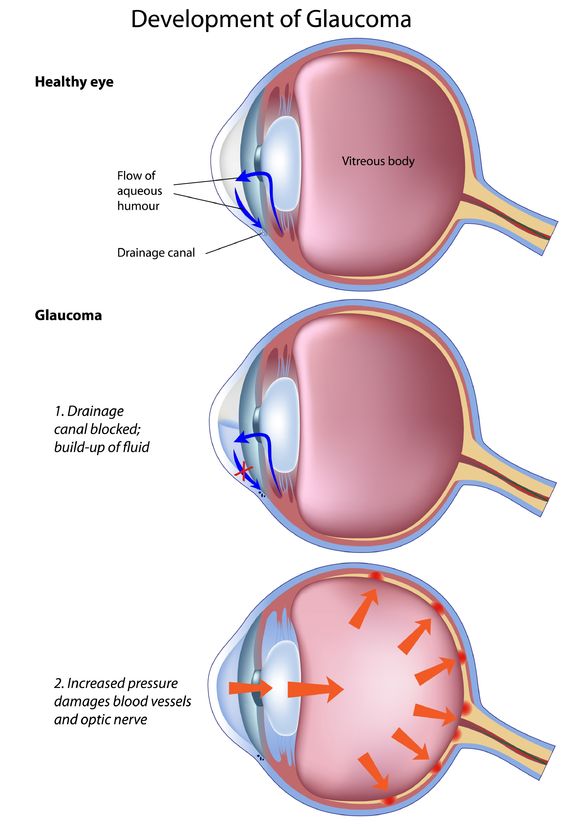Glaucoma
 Glaucoma is a common disease that causes irreversible blindness, if not detected and treated early. It is one of the leading causes of vision loss in the United States. It is often called the ‘silent thief of sight’ as it often does not present with any discernible change in vision until the disease is far advanced.
Glaucoma is a common disease that causes irreversible blindness, if not detected and treated early. It is one of the leading causes of vision loss in the United States. It is often called the ‘silent thief of sight’ as it often does not present with any discernible change in vision until the disease is far advanced.
Glaucoma is usually associated with elevated intraocular pressure, which causes optic nerve damage and constriction of the field of vision, which eventually leads to blindness. There are two basic types of glaucoma; they can be classified as Open-angle glaucoma and Closed-angle glaucoma.
Open-angle glaucoma is the most common type, occurring in approximately 90% of glaucoma patients. Symptoms can develop slowly and remain undetected for years.
They include:
- Gradual loss of peripheral vision, usually in both eyes
- Tunnel vision in the advanced stages
Closed-angle glaucoma affects less than 10% of patients with glaucoma, however, it is much more rapid in its onset. Symptoms can occur suddenly and be quite severe.
These include:
- Severe eye pain
- Nausea and vomiting accompanying eye pain
- Sudden onset of visual disturbance, often in low light
- Blurred vision
- Halos around lights
- Eye redness
There is no cure for the disease, but fortunately it is highly treatable. It can be controlled with medication, laser therapy or surgery. Glaucoma needs close follow up care, preferably by a Glaucoma Specialist, to prevent progression of the disease.
Glaucoma can occur in any patient of any age, but certain risk factors increase the chances of this disease occurring.
These risk factors include:
- Age greater than 60 years
- African-American, Hispanic or Asian descent
- Family history of glaucoma
- Increased eye pressure
- Severe nearsightedness
Other risk factors may be identified during eye examination, such as steroid use, chronic inflammation and eye trauma.
 First-line treatment options for glaucoma include medical therapy for patients who can tolerate medications and who are compliant in using eye drops as part of their daily regimen for the rest of their lives. Laser therapy (SLT) is also an effective first-line option for patients who cannot tolerate medication side effects, or who have an active lifestyle and prefer to avoid the daily routine of using drops, or in patients whose glaucoma is not sufficiently controlled using medication therapy. Laser therapy is a good in-office treatment option that takes approximately ten minutes, is painless, and has achieved excellent success in many patients. This option may help the patient avoid more invasive surgeries, and may even reduce dependence on drops.
First-line treatment options for glaucoma include medical therapy for patients who can tolerate medications and who are compliant in using eye drops as part of their daily regimen for the rest of their lives. Laser therapy (SLT) is also an effective first-line option for patients who cannot tolerate medication side effects, or who have an active lifestyle and prefer to avoid the daily routine of using drops, or in patients whose glaucoma is not sufficiently controlled using medication therapy. Laser therapy is a good in-office treatment option that takes approximately ten minutes, is painless, and has achieved excellent success in many patients. This option may help the patient avoid more invasive surgeries, and may even reduce dependence on drops.
Glaucoma surgery is usually reserved for those whose glaucoma is uncontrolled and progressing while on medical and laser therapy. There are several forms of surgical therapy. The surgical treatment of choice is tailored for each individual patient depending on the severity of the disease, target intraocular pressure, and other factors. Surgical options include traditional techniques such as trabeculectomy with antimetabolite, EX-PRESS Shunt, Ahmed glaucoma tube, and Baerveldt or Molteno drainage devices.
Recent advances in glaucoma care have led to the development of minimally invasive glaucoma surgeries (MIGS), including iStent, canaloplasty, trabectome, cyclophotocoagulation (CPC), and endocytophotocoagulation (ECPC). These procedures are less invasive and are very safe approaches to glaucoma surgery.
Regular screening for glaucoma, especially in patients with risk factors, is of utmost importance in preventing irreversible loss of vision by this silent disease. An annual, fully dilated eye examination is recommended.





